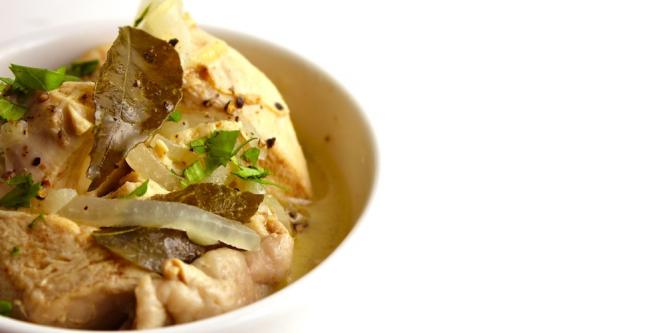From salads and seasonings to wrappers and garnishes, there are as many kinds and uses of leaves in cookery as there are – what else? – leaves on a tree. And that’s just the tree in your own backyard, so to speak. For every familiar bay leaf or sprig of mint used on one side of the globe, there’s an equally common counterpart on the other.
Abundant in markets and often found in home gardens throughout Asia, the following three cooking leaves are used in a variety of recipes ranging from drinks to desserts. In the West, they are most likely available at Asian grocers either frozen or as extracts, although they are increasingly being offered fresh as well. For a different flavor in your next recipe, consider adding these aromatic leaves to your pantry.
 If you like infusing savory
sauces and sweet creams with herbs such as basil or mint, try…
If you like infusing savory
sauces and sweet creams with herbs such as basil or mint, try…
Kaffir Lime Leaves. One of the key ingredients in Thai cuisine, kaffir lime leaves are used to flavor soups, stir-fries and sauces, as well as desserts. Like the zest of other citrus fruits, these figure-eight leaves are full of aromatic oils that infuse food with an intense floral-citrus taste. Kaffir lime is particularly well matched with coconut milk – a winning combination in Thai curries and soups.
- Glossy, thick kaffir lime leaves stand up well to high heat, making them ideal to steep in hot syrup, broth or milk. However, they are not normally eaten unless very finely shredded. Although they are available in dried and essential oil forms, fresh leaves are preferred and can be refrigerated for up to two weeks. Look for them in Asian markets with a wide selection of Thai ingredients.
- Kaffir lime and coconut milk go together like strawberries and cream, and make equally refreshing, velvety desserts such as an Asian-inspired panna cotta.

If you like cooking en papillote, try…
Pandan Leaves. Looking more like enormous blades of grass than leaves, pandan is cherished by Southeast Asian palates for its distinctive fragrance and flavor that elude easy description (from toasted nuts to delicate floral). As such, it is very versatile: Knotted leaves are added to rice during cooking; boiled to make a sweet tea-like beverage; and used so extensively in baked goods, custards, ice creams and other desserts that it has been dubbed the ‘Asian vanilla’.
- Pandan leaves are used primarily for flavoring, not eating, and are usually discarded before serving. They rapidly lose their unique scent as they dry, so if not found fresh in Asian markets, check out the freezer section or look for bottled liquid essence (usually tinted bright green).
- A simple online search for pandan yields well over 250,000 recipes, including several for pandan-wrapped Thai fried chicken (gai hor bai toey).
If you like using whole-leaf seasonings such as bay leaves, try…
 Curry Leaves.
When is curry not curry? When it’s a fragrant leaf essential
to South Indian, Sri Lankan and Southeast Asian cookery, but not an ingredient
in the ground spice mixture with which it shares a name. These arrow shaped
leaves have a peppery, slightly citrus-y scent that is amplified when toasted
or fried along with other aromatics such as ginger, garlic and onions. Although
fresh curry leaves feel firm in texture, they soften significantly when cooked
and may be eaten safely.
Curry Leaves.
When is curry not curry? When it’s a fragrant leaf essential
to South Indian, Sri Lankan and Southeast Asian cookery, but not an ingredient
in the ground spice mixture with which it shares a name. These arrow shaped
leaves have a peppery, slightly citrus-y scent that is amplified when toasted
or fried along with other aromatics such as ginger, garlic and onions. Although
fresh curry leaves feel firm in texture, they soften significantly when cooked
and may be eaten safely.
- Curry leaves quickly lose their lovely aroma when dried, so look for bunches of fresh fronds at Indian or South Asian markets. Choose dark green leaves free of brown spots or patches, and keep them on their stems until ready to use. Curry leaves may be refrigerated for up to two weeks.
- Use in saucy curries and rice dishes, or add to sautéed or fried seafood, meat and vegetables.
 Curry Leaf Chicken in Yogurt Sauce
Curry Leaf Chicken in Yogurt Sauce
Ingredients
1 ½ lbs boneless chicken, cut into large chunks
1 tsp salt
2 Tbsps vegetable oil
2 tsps ground cumin
8-10 curry leaves
1 med onion, cut in half then sliced thinly
3-4 cloves of garlic
½ cup chicken stock
½ cup plain yogurt (Greek-style for a thicker sauce, regular or low-fat for thinner)
1-2 tsps cracked black pepper
Salt to taste
Place chicken chunks in a small bowl, sprinkle with salt and set aside. Heat vegetable oil in a sauté pan over medium high heat. Add cumin and curry leaves, and fry carefully – the leaves will start to pop as they release moisture into the hot oil. Cook until soft and fragrant.
Add chicken chunks and sauté; about halfway through, add garlic and onions. When chicken is nicely browned and onions are soft, add chicken broth. Bring it to a boil, then reduce heat and gently simmer uncovered for about 10 minutes.
Turn off the heat to allow mixture to settle from its simmer, and then add the yogurt and black pepper, stirring to combine. Serve with steamed rice.

Tracey Paska lives, eats and writes in Manila, Philippines, where she revels in the fact that she can wear flip-flops outdoors in January. When she's not exploring Manila's foodscape, she freelances for a national food magazine and writes about the complex and fascinating connections between food, culture, and society on her blog Tangled Noodle. Her last post for us was: Raw but Cooked: cooking with acids.




